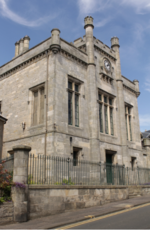Kirkcaldy ( kur-KAW-dee; Scots: Kirkcaldy; Scottish Gaelic: Cair Chaladain) is a town and former royal burgh in Fife, on the east coast of Scotland. It is about 11.6 miles (19 km) north of Edinburgh and 27.6 miles (44 km) south-southwest of Dundee. The town had a recorded population of 49,460 in 2011, making it Fife's second-largest settlement and the 12th most populous settlement in Scotland.
Kirkcaldy has long been nicknamed the Lang Toun (; Scots for "long town") in reference to the early town's 0.9-mile (1.4 km) main street, as indicated on maps from the 16th and 17th centuries. The street would finally reach a length of nearly 4 miles (6.4 km), connecting the burgh to the neighbouring settlements of Linktown, Pathhead, Sinclairtown and Gallatown, which became part of the town in 1876. The formerly separate burgh of Dysart was also later absorbed into Kirkcaldy in 1930 under an act of Parliament.
The area around Kirkcaldy has been inhabited since the Bronze Age. The first document to refer to the town is from 1075, when Malcolm III granted the settlement to the church of Dunfermline. David I later gave the burgh to Dunfermline Abbey, which had succeeded the church: a status which was officially recognised by Robert I in 1327. The town only gained its independence from Abbey rule when it was created a royal burgh by Charles I in 1644.
From the early 16th century, the establishment of a harbour at the East Burn confirmed the town's early role as an important trading port. The town also began to develop around the salt, coal mining and nail making industries. The production of linen which followed in 1672 was later instrumental in the introduction of floorcloth in 1847 by linen manufacturer, Michael Nairn. In 1877 this in turn contributed to linoleum, which became the town's most successful industry: Kirkcaldy was a world producer until well into the mid-1960s. The town expanded considerably in the 1950s and 1960s, though the decline of the linoleum industry and other manufacturing restricted its growth thereafter.
Today, the town is a major service centre for the central Fife area. Public facilities include a main leisure centre, theatre, museum and art gallery, three public parks and an ice rink. Kirkcaldy is also known as the birthplace of social philosopher and economist Adam Smith who wrote his magnum opus The Wealth of Nations in the town. In the early 21st century, employment is dominated by the service sector: the biggest employer in the town is PayWizard, formerly known as MGT plc (call centre). Other main employers include NHS Fife, Forbo (linoleum and vinyl floor coverings), Fife College, Whitworths (flour millers) and Smith Anderson (paper making).











